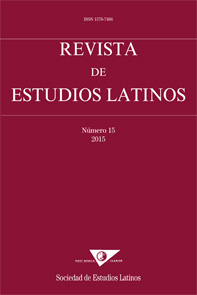Deux types de clausules remarquables dans les trimètres de Sénèque. À partir du cas de l’Oedipe Antoine Foucher
DOI:
https://doi.org/10.23808/rel.v15i0.87694Palabras clave:
Sénèque ; trimètre ; mots longs ; mots crétiques ; prosaïsmeResumen
L’étude des mots longs finaux confirme la conclusion de Jean Soubiran : rares, ces mots sont dotés d’une force sémantique qui est clairement associée au travail de réminiscence opéré par Œdipe. Les mots crétiques finaux ont eux aussi une singularité propre : également rares, mais moins que les mots longs, ils introduisent dans le discours tragique une perturbation, métrique et surtout lexicale ; car ce sont essentiellement des prosaïsmes. C’est pourquoi ils sont associés plus spécifiquement à des contextes de forte tension dramatique ou pathétique.Descargas
Los datos de descargas todavía no están disponibles.
Descargas
Publicado
15-12-2015
Cómo citar
Foucher, A. (2015) «Deux types de clausules remarquables dans les trimètres de Sénèque. À partir du cas de l’Oedipe Antoine Foucher», Revista de Estudios Latinos, 15, pp. 29–51. doi: 10.23808/rel.v15i0.87694.
Número
Sección
Artículos
Licencia
Derechos de autor 2015 Revista de Estudios Latinos

Esta obra está bajo una licencia internacional Creative Commons Atribución-NoComercial-SinDerivadas 4.0.
Los originales publicados en las ediciones impresa y electrónica de esta revista son propiedad de las personas autoras de los mismos y se podrán difundir y transmitir siempre que se identifique la fuente original y la autoría en cualquier reproducción total o parcial de los mismos, y siempre que no tengan una finalidad comercial.






